Genre blending, a phenomenon that has gained significant traction in the music industry, refers to the fusion of different musical styles to create innovative and unique sounds. This artistic approach allows musicians to transcend traditional boundaries, offering listeners a fresh auditory experience that often defies categorization. As artists experiment with various influences, they not only expand their creative horizons but also challenge the conventions of genre classification.
The result is a rich tapestry of sound that reflects the diverse cultural landscape of contemporary society. The allure of genre blending lies in its ability to resonate with a wide audience. By merging elements from disparate genres, artists can appeal to fans of multiple styles, fostering a sense of inclusivity and broadening their listener base.
This cross-pollination of musical ideas has led to the emergence of new subgenres and has revitalized interest in older styles, demonstrating the dynamic nature of music as an evolving art form. As we delve deeper into the history, impact, and future of genre blending, it becomes evident that this practice is not merely a trend but a fundamental aspect of modern music creation.
Key Takeaways
- Genre blending is the combination of different musical styles to create a unique sound that transcends traditional genre boundaries.
- Genre blending in music has a long history, with artists experimenting with different styles and influences to create innovative and groundbreaking music.
- The impact of genre blending on the music industry has been significant, leading to the creation of new subgenres and expanding the audience for diverse types of music.
- The art of blending genres involves various techniques and approaches, such as incorporating elements of different styles, experimenting with instrumentation, and fusing cultural influences.
- Technology has played a crucial role in genre blending, enabling artists to access a wide range of sounds, collaborate with musicians from different parts of the world, and experiment with new production techniques.
Exploring the History of Genre Blending in Music
The roots of genre blending can be traced back to the early 20th century when jazz musicians began incorporating elements from various musical traditions, including blues, ragtime, and folk music. This period marked a significant departure from the rigid structures of classical music and paved the way for improvisation and experimentation. Artists like Louis Armstrong and Duke Ellington exemplified this blending by infusing their compositions with diverse influences, setting the stage for future generations to explore the possibilities of genre fusion.
As the decades progressed, genre blending continued to evolve. The 1960s and 1970s saw the rise of rock music, which frequently borrowed from blues, country, and even classical elements. Bands like The Beatles and The Rolling Stones were instrumental in this movement, incorporating diverse sounds into their work.
The emergence of funk and soul further exemplified this trend, as artists like Sly and the Family Stone and Aretha Franklin blended rhythm and blues with rock influences, creating a new sonic landscape that resonated with audiences worldwide. This historical context highlights how genre blending has been a driving force in shaping the musical landscape over time.
The Impact of Genre Blending on the Music Industry
The impact of genre blending on the music industry is profound and multifaceted. One of the most significant effects is the democratization of music creation. As artists draw inspiration from various genres, they often break free from the constraints imposed by traditional record labels and industry standards.
This shift has led to a more diverse array of sounds being produced, allowing for greater artistic expression and innovation. Independent artists can now reach audiences through digital platforms, bypassing conventional gatekeepers and fostering a more inclusive musical environment. Moreover, genre blending has transformed marketing strategies within the industry. Record labels are increasingly recognizing the potential for crossover hits that appeal to multiple demographics. This has led to collaborations between artists from different genres, resulting in chart-topping singles that might not have been possible within the confines of a single genre.
For instance, collaborations between hip-hop artists and pop singers have produced some of the most commercially successful tracks in recent years, illustrating how genre blending can create lucrative opportunities for both artists and labels alike.
The Art of Blending Genres: Techniques and Approaches
| Technique | Description |
|---|---|
| Hybridization | Combining elements from different genres to create a new, unique style. |
| Layering | Overlaying different genres within the same piece to create depth and complexity. |
| Subversion | Twisting traditional genre conventions to create unexpected and thought-provoking work. |
| Interpolation | Integrating elements from one genre into another to create a seamless blend. |
Blending genres is not merely an act of combining different musical elements; it requires a nuanced understanding of each genre’s characteristics and conventions. Musicians often employ various techniques to achieve a seamless fusion. One common approach is the use of hybrid instrumentation, where artists incorporate instruments traditionally associated with one genre into another.
For example, a country artist might use electronic beats or synthesizers typically found in pop or hip-hop music, creating a unique sound that retains elements of both styles. Another technique involves rhythmic experimentation. Artists may take the foundational rhythms of one genre and overlay them with melodic structures from another.
This can lead to innovative compositions that challenge listeners’ expectations.
Her use of unconventional song structures and production techniques exemplifies how artists can push boundaries while maintaining their unique artistic identity.
The Role of Technology in Genre Blending
Technology plays a pivotal role in facilitating genre blending in contemporary music. Advances in digital audio workstations (DAWs) have empowered musicians to experiment with sounds and styles in ways that were previously unimaginable. With access to an array of virtual instruments, samples, and effects, artists can easily manipulate their recordings to create hybrid sounds that reflect their diverse influences.
This democratization of technology has lowered barriers to entry for aspiring musicians, allowing them to produce high-quality music from their home studios. Additionally, streaming platforms have revolutionized how listeners discover and consume music. Algorithms that curate playlists based on user preferences often introduce listeners to tracks that blend genres they may not have explored otherwise.
This exposure encourages fans to embrace a wider range of musical styles, further fueling the trend of genre blending. As listeners become more open to diverse sounds, artists are inspired to continue pushing creative boundaries, resulting in an ever-evolving musical landscape.
Case Studies: Successful Examples of Genre Blending in Music
Several artists have successfully navigated the complexities of genre blending, creating iconic works that resonate across multiple demographics. One notable example is Lil Nas X’s “Old Town Road,” which seamlessly fuses country and hip-hop elements. The track’s catchy melody combined with its rap verses challenged traditional notions of both genres and sparked widespread discussion about what constitutes country music in the modern era.
Its unprecedented success on the Billboard charts exemplifies how genre blending can break down barriers and redefine musical categories. Another compelling case study is the collaboration between rock band Linkin Park and rapper Jay-Z on their EP “Collision Course.” This project showcased how two seemingly disparate genres could coexist harmoniously through innovative arrangements and production techniques. By blending rock instrumentation with hip-hop beats and lyrical delivery, Linkin Park and Jay-Z created a sound that appealed to fans across both genres, demonstrating the commercial viability of such collaborations.
Challenges and Controversies in Genre Blending
Despite its many advantages, genre blending is not without its challenges and controversies. One significant issue is the potential for cultural appropriation, where artists may draw from genres rooted in specific cultural contexts without fully understanding or respecting their origins. This can lead to backlash from communities whose musical traditions are being co-opted for commercial gain.
For instance, when white artists adopt elements from hip-hop or reggae without acknowledging their roots or contributing back to those communities, it raises ethical questions about authenticity and respect. Additionally, genre blending can sometimes result in diluted sounds that fail to resonate with purists from either genre involved. Critics may argue that certain blended tracks lack the depth or authenticity found in traditional forms of music.
This tension between innovation and preservation often sparks debates within music communities about what constitutes “real” music and whether genre blending enhances or undermines artistic integrity.
The Future of Genre Blending: Trends and Innovations
Looking ahead, the future of genre blending appears promising as artists continue to explore new sonic territories. One emerging trend is the rise of global fusion genres that incorporate influences from various cultural backgrounds. As globalization facilitates cross-cultural exchanges, musicians are increasingly drawing inspiration from non-Western musical traditions, leading to innovative blends that reflect a more interconnected world.
For example, artists like Bad Bunny have successfully merged reggaeton with elements from rock and pop, creating a sound that resonates with diverse audiences.
AI-driven tools can analyze vast amounts of musical data to identify patterns and suggest innovative combinations that artists may not have considered otherwise.
This technology could lead to entirely new genres emerging from unexpected fusions, pushing the boundaries of creativity even further. As we navigate this evolving landscape, it is clear that genre blending will continue to play a vital role in shaping the future of music. The ongoing dialogue between tradition and innovation will inspire artists to explore new possibilities while honoring the rich tapestry of musical history that informs their work.
If you’re interested in exploring the intersection of technology and creativity, you might find the concept of a “Mashup” intriguing. A mashup typically involves combining data or functionality from multiple sources to create something new and innovative. For those who enjoy the creative process, understanding color theory can be an essential skill. You can enhance your design projects by using online tools to select the perfect color palette. Check out this Ultimate Guide to Online Color Pickers for a comprehensive overview of tools that can help you choose the right colors for your mashup projects.


















+ There are no comments
Add yours